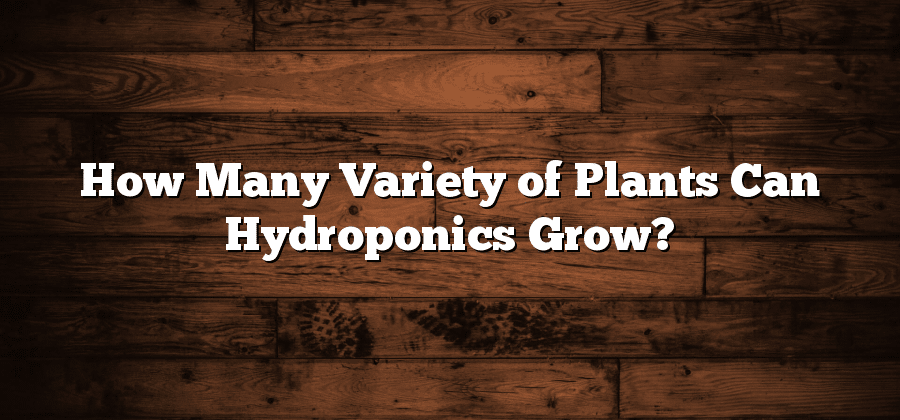Benefits of Hydroponics for Plant Growth
Hydroponics, a method of growing plants without soil, offers numerous benefits for plant growth. One of the main advantages is that it allows for the precise control of nutrient levels. This means that plants can receive exactly what they need, when they need it, resulting in optimal growth and development. Additionally, hydroponics provides plants with a constant supply of water, eliminating the risk of under or overwatering. This helps to maintain the ideal moisture levels for plant growth, further promoting healthy and vigorous plants.
Furthermore, hydroponic systems have the potential to produce higher yields compared to traditional soil-based cultivation. By providing plants with all the essential nutrients they require, and optimizing the growing conditions, hydroponics can enhance the overall productivity of crops. This not only benefits farmers and growers by increasing their potential profits, but also contributes to food security, as more plants can be grown in limited spaces. Additionally, hydroponic systems can be set up in urban areas or regions with poor soil quality, allowing for agriculture to thrive in areas that were previously deemed unsuitable for cultivation.
Ideal Conditions for Hydroponic Plant Growth
Hydroponics, a method of growing plants without soil, offers numerous benefits for plant growth. However, to achieve optimal results, it is essential to provide ideal conditions for hydroponic plant growth. Firstly, maintaining the correct temperature is crucial. Most plants thrive in temperatures ranging from 65°F to 80°F (18°C to 27°C). Fluctuations in temperature can stress the plants, hindering their growth and development. Therefore, it is important to monitor the temperature consistently and make adjustments as needed to create a stable environment for the plants.
In addition to temperature, proper lighting is crucial for successful hydroponic plant growth. Natural sunlight is, of course, the best source of light. However, when growing plants indoors or in areas with limited sunlight, artificial lighting becomes necessary. For most plants, a combination of red and blue spectrum LED lights provides the necessary wavelengths for photosynthesis. It is important to position the lights at an appropriate distance from the plants to ensure that they receive the right amount of light without causing stress or damage. Additionally, the duration of light exposure should mimic the natural day-night cycle to maintain plant health and encourage growth.
Popular Plant Varieties for Hydroponics
Popular Plant Varieties for Hydroponics
Hydroponics, the method of growing plants without soil, has gained popularity in recent years due to its many benefits. One of the advantages of hydroponics is the ability to grow a wide range of plant varieties efficiently. Whether you are a home gardener or a commercial farmer, there are popular plant varieties that thrive in hydroponic systems.
Leafy greens such as lettuce, spinach, kale, and Swiss chard are some of the most popular plant varieties for hydroponics. These plants have shallow root systems and grow relatively quickly, making them perfect for hydroponic setups. Herbs like basil, mint, and parsley are also commonly grown hydroponically for their intense flavors and high market value. Additionally, vine crops such as tomatoes, cucumbers, and peppers can also be successfully cultivated in hydroponic systems, providing a bountiful harvest year-round.
The versatility of hydroponics allows for experimentation with a range of plant varieties. As technology and research continue to advance, it is likely that more plants will be identified as suitable for hydroponic cultivation. However, it is important to choose plant varieties that are well-suited for the specific conditions of your hydroponic system, as each plant has distinct requirements for optimal growth. Careful selection and proper management of plant varieties are key factors in achieving success in hydroponics.
Challenges in Growing Certain Plants Hydroponically
Hydroponics, with its innovative approach to plant cultivation, has revolutionized the agricultural industry. However, despite the many advantages it offers, there are still certain challenges that arise when attempting to grow specific plants hydroponically. One of the primary issues faced by growers is the inability to mimic the exact environmental conditions required by certain plant species. This can be particularly problematic for plants that are adapted to specific soil types or climates.
Another challenge encountered in hydroponic plant growth relates to the nutrient requirements of different plant varieties. While hydroponic systems provide a controlled environment for nutrient delivery, it can be challenging to achieve the exact balance of nutrients needed for optimal growth. Variations in plant nutrient uptake and the availability of essential elements can result in deficiencies or toxicities, affecting the overall health and productivity of the plants.
It is essential for hydroponic growers to address these challenges by conducting thorough research on the specific plants they intend to cultivate. By understanding the unique environmental and nutrient requirements of each plant variety, growers can implement tailored strategies to overcome these hurdles and ensure successful hydroponic cultivation.
Tips for Choosing Plants for Hydroponic Systems
Hydroponics offers an innovative and efficient way to grow plants without soil. When it comes to choosing the right plants for your hydroponic system, there are a few important factors to consider. First and foremost, it is essential to select plants that are well-suited for hydroponic cultivation. While many plant varieties can thrive in a hydroponic environment, some are better suited than others.
Consider the growth requirements of the plants you are interested in. Some plants prefer specific pH levels or nutrient concentrations in the hydroponic solution. It is crucial to match these requirements with the capabilities of your hydroponic system. Additionally, take into account the space available in your setup. Some plants, such as lettuce or herbs, have a compact growth habit and are well-suited for confined spaces. On the other hand, crops like tomatoes or cucumbers require more vertical space and might be better suited for larger systems. By carefully selecting plants that align with your hydroponic system’s capabilities, you can ensure optimal growth and yield.






